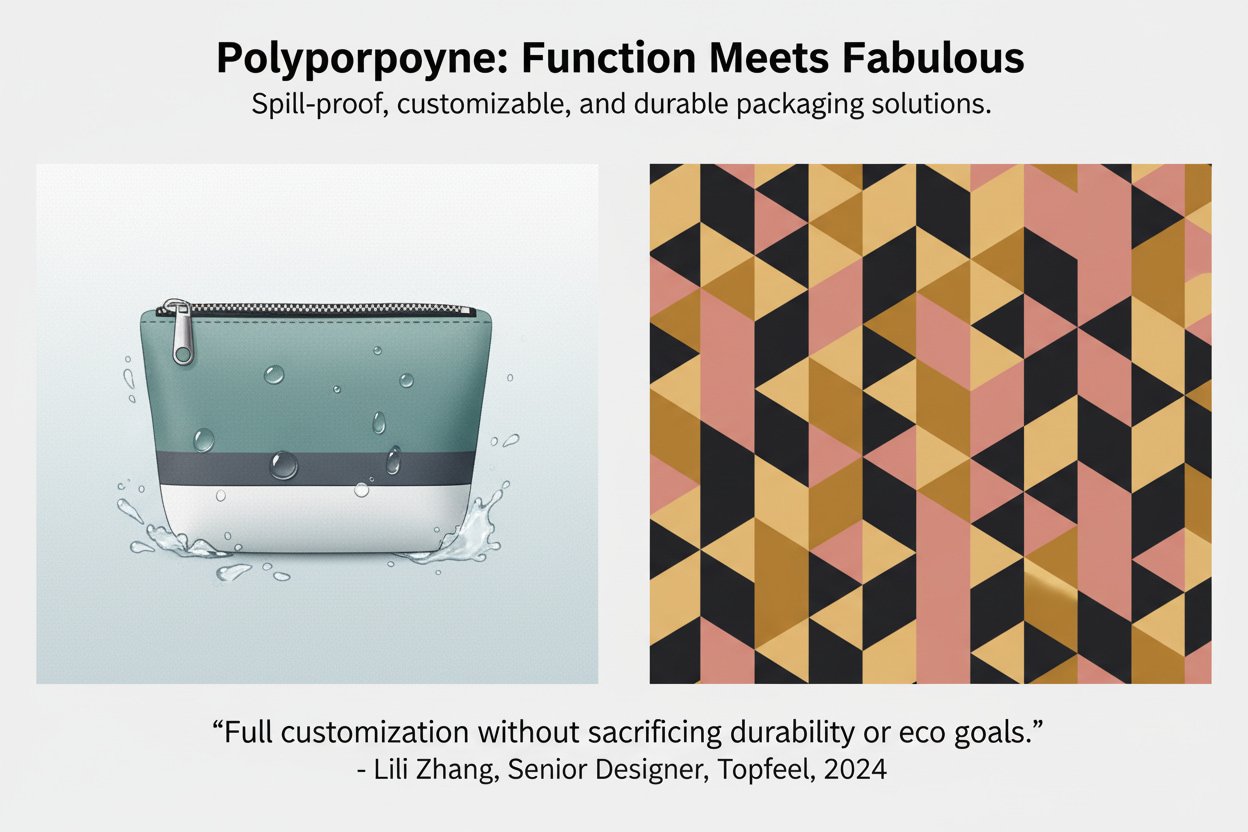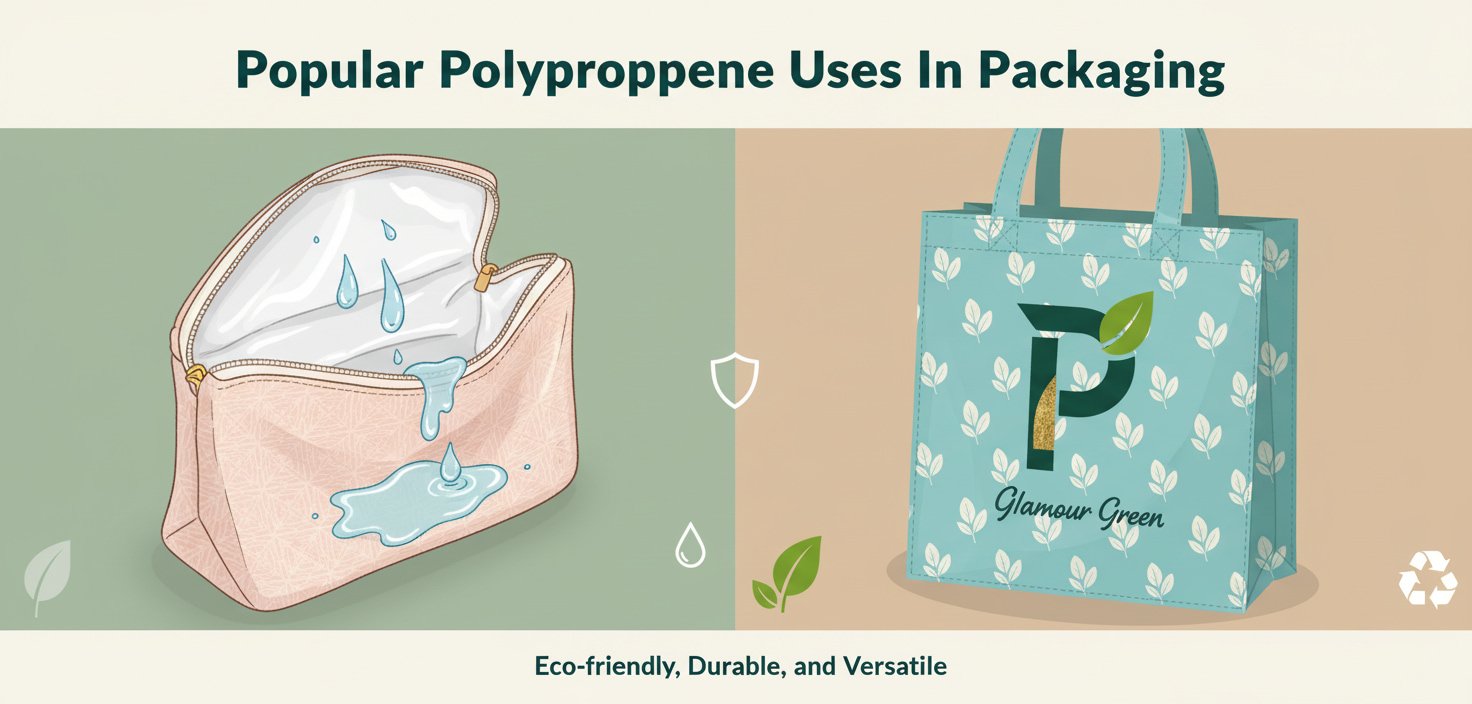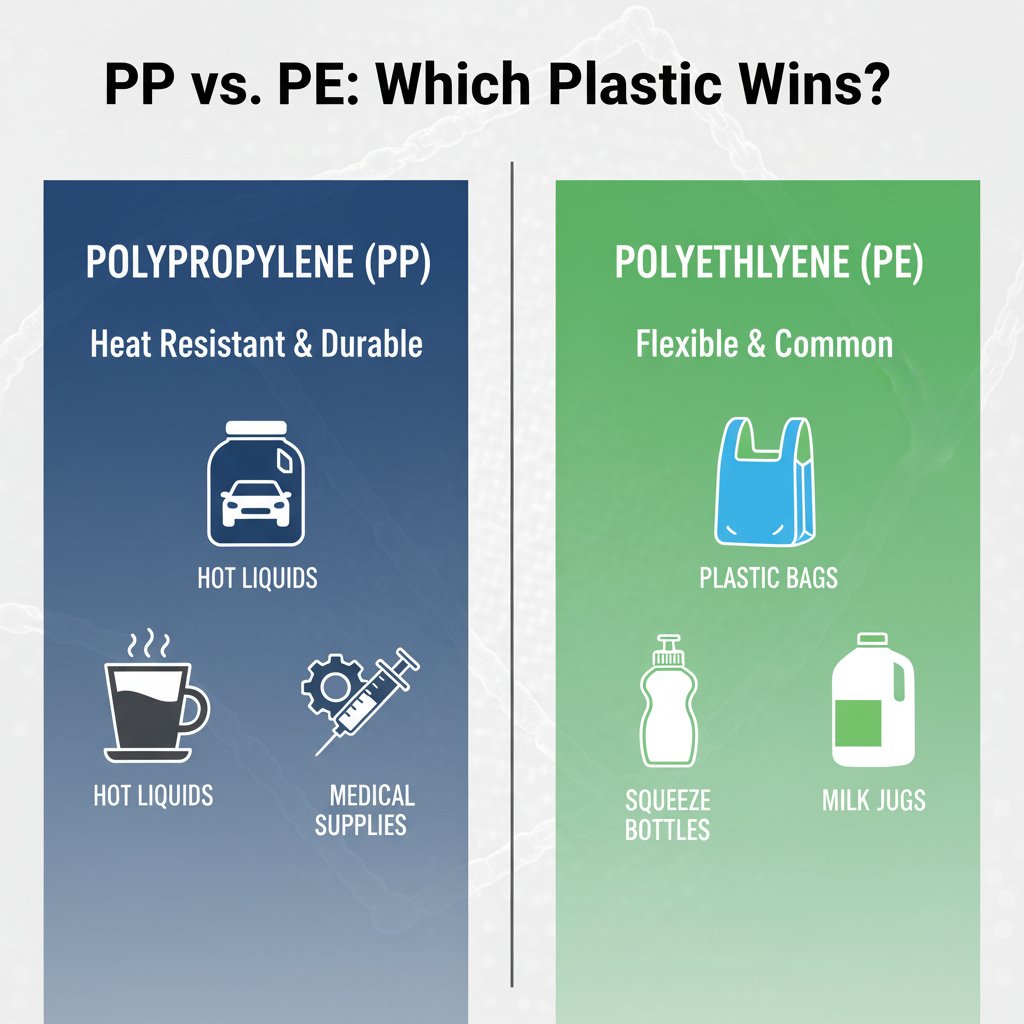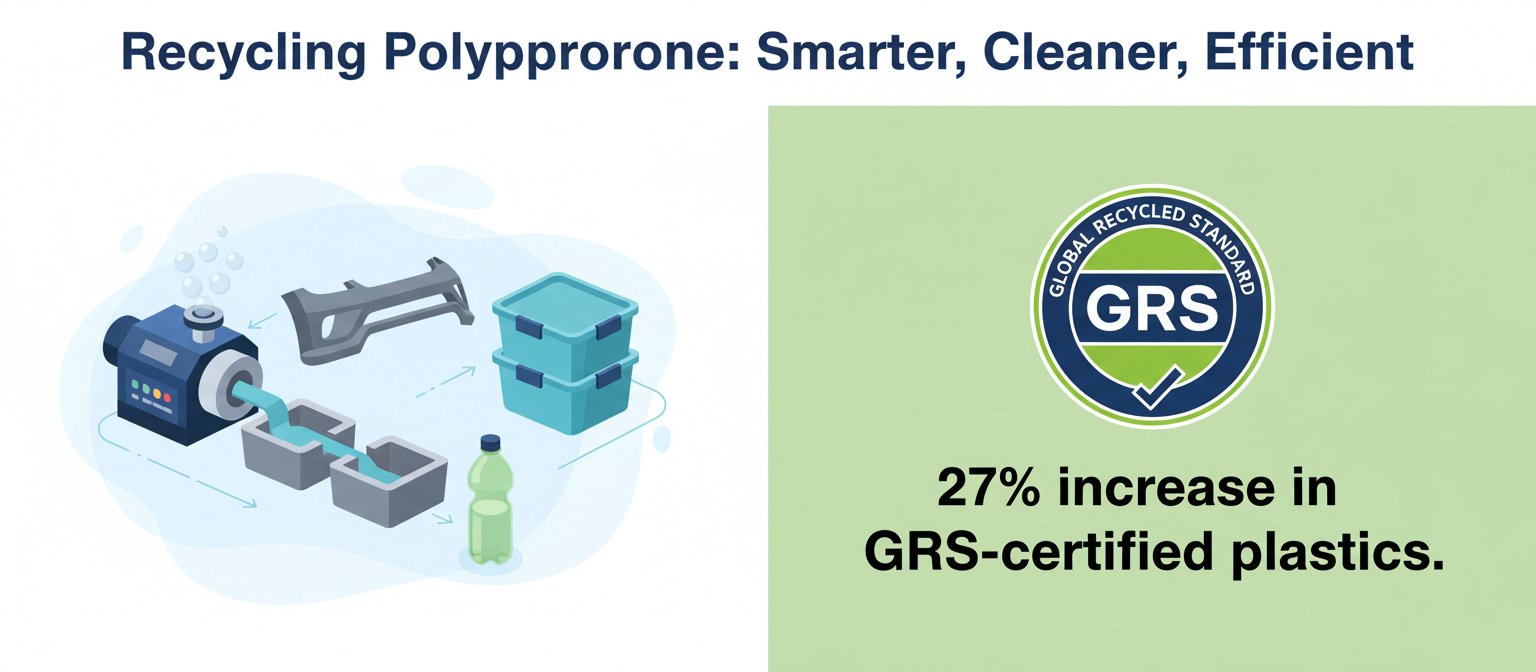What Is Polypropylene Plastic? Polypropylene PP Uses

Ever tossed your makeup pouch into a suitcase, only to find it soggy from a shampoo explosion? That’s exactly where Polypropylene, Plastic, PP, Uses come in hot. This stuff isn’t just some boring industrial material—it’s the MVP behind spill-proof cosmetic bags that don’t quit. Lightweight like a feather but tough as nails, PP plastic is what big beauty brands swear by when they need custom pouches that look sharp and hold up under pressure (and perfume leaks).
Turns out, “function meets fabulous” isn’t just marketing fluff. According to Topfeel’s senior designer Lili Zhang in a 2024 product insight session: “Polypropylene lets us offer full customization—colors, logos, zippers—without sacrificing durability or eco goals.” So yeah, it checks all the boxes for B2B buyers who want bulk orders done fast and on-brand.
Polypropylene Plastic Uses By Industry
From beauty kits to travel cases, the versatility of polypropylene plastic shows up across industries. Here’s how different sectors are using it smartly.
Beauty Industry Solutions with Custom Cosmetic Travel Bags
- Waterproof lining keeps products safe from spills and humidity.
- Zipper compartments prevent messy leaks during travel.
- Transparent PP windows let users see what’s inside without opening.
These cosmetic bags made from polypropylene blends are tough, stylish, and easy to clean—ideal for makeup artists or everyday travelers. With high chemical resistance, they handle oils and serums like a champ.
Custom printing options mean brands can match bag designs with seasonal campaigns or influencer collaborations—turning packaging into a marketing tool.
Retail Packaging Options Featuring High-Quality PP Composite
→ Eye-catching textures: Matte, glossy, woven patterns available for shelf appeal.
→ Functional strength: Rigid yet flexible thermoplastic polymer supports heavier items safely.
→ Branding canvas: Printable surfaces allow vibrant logos or QR codes.
Retailers love the combo of durability and aesthetics that PP composite offers. Market research from Future Market Insights indicates retailers are shifting toward recyclable polymers like polypropylene due to rising consumer demand for sustainable packaging. That’s a big win for both branding and eco-conscious shoppers.
Travel Accessories: Lightweight Durable PP Woven Fabric Cases
• Featherlight but built tough—perfect for overhead bins or under-seat storage.
• Water-resistant outer layer protects electronics and documents on rainy days.
• Reinforced stitching handles heavy loads without tearing or fraying.
Made from tightly woven PP fabric, these carry-ons don’t just survive airport chaos—they thrive in it. The high melting point ensures they won’t warp under heat either, making them ideal companions on summer adventures or tropical getaways.
Promotional Events—Personalized PP Bags for Corporate Giveaways
- Step One: Choose your bag style—tote, drawstring, messenger pouch? Each has its own vibe.
- Step Two: Add your brand logo using heat transfer or silk screen printing techniques tailored for plastic-based materials like polypropylene.
- Step Three: Pick color schemes that pop at trade shows but still align with brand identity.
The result? A budget-friendly giveaway that’s actually useful—and memorable long after the event ends.
Bonus Perks Across Industries Using Polypropylene Bags
Easy customization makes them fit any niche market—from wellness kits to tech gear sleeves. Their lightweight nature slashes shipping costs across supply chains globally. Recyclable properties contribute to companies’ ESG goals without sacrificing quality.
Across verticals, this adaptable material keeps proving its worth—not just as a packaging solution but as a strategic asset that balances form, function, and sustainability.
Why Polypropylene Remains an Industry Favorite
It resists moisture better than paperboard boxes and holds shape longer than many biodegradable plastics out there today. When you factor in its low cost per unit combined with strong tensile strength—it’s no wonder companies keep coming back to this versatile material time after time.
In short? If you’re looking for practical yet polished solutions across retail, beauty, travel—or even events—you’ll find that well-designed applications of polypropylene plastic tick all the right boxes every single time.
Popular Polypropylene Uses In Packaging
Polypropylene’s versatility makes it a go-to material across packaging—from beauty bags to sustainable wraps.
Spill-Proof Cosmetic Pouches with Waterproof and Spill-Proof Lining
Polypropylene really shines when it comes to making beauty pouches that don’t leak or soak through. These pouches are lined with a waterproof PP barrier, keeping your serums and creams safely contained.
- Keeps spills from staining bags or purses
- Lightweight yet tough enough for daily use
- Resistant to moisture, oils, and alcohol-based products
You’ll often find these used for travel kits or sample packs because they’re easy to clean and hold their shape. The plastic structure is also flexible enough to zip, snap, or fold without breaking down over time.
Wholesale Custom Printed Bags for Promotional Beauty Product Distribution
Custom printed polypropylene bags are a favorite among cosmetics brands trying to make a splash at events or retail counters. Why? Because they’re cheap, durable, and super easy to brand.
- Brands can print logos directly onto the PP plastic, even in full color.
- These bags hold up well under weight—ideal for samples or small product bundles.
- They’re reusable giveaways that double as walking advertisements.
★ Whether it’s a trade show freebie or part of an influencer PR kit, these promo bags blend style with function—and keep your brand top of mind long after the event ends.
Eco-Friendly Packaging with Recycled Polypropylene Material
Eco-conscious brands aren’t just talking green—they’re switching over to recycled polypropylene packaging materials that reduce waste without losing quality.
• Recycled PP plastic uses 70% less energy than virgin material during production
• It can be reprocessed multiple times while retaining structural integrity
• Great for brands aiming for carbon footprint reduction
More beauty companies are ditching single-use plastics in favor of recycled content—without compromising on waterproofing or branding flexibility. It’s no surprise that even names like Topfeel have explored greener packaging options using post-consumer recycled PP materials, showing you can go eco without going flimsy.
Pp Vs Pe: Which Plastic Wins?
Two giants in the plastic world—Polypropylene (PP) and Polyethylene (PE)—go head-to-head. Let’s break down what makes each one tick and where they shine.
Polypropylene (PP)
- Durable under pressure: Thanks to its high melting point, PP holds up better when exposed to heat, making it a go-to for hot-fill packaging and dishwasher-safe containers.
- Tough but lightweight: It balances strength with low density, so you get durability without bulk.
- Chemical resistance: From acids to solvents, most chemicals bounce right off this stuff.
It’s also got a bit of flex—not as much as PE—but just enough to resist cracking under stress.
You’ll see it everywhere: automotive parts, reusable food containers, medical syringes, even carpets. That’s how versatile it is.
Want something recyclable? PP is coded as #5 plastic and can be reprocessed into signal lights or battery cables.
Grouped applications:
- Industrial use: piping systems, chemical tanks
- Textile industry: thermal underwear, rugs
- Packaging: yogurt tubs, bottle caps
Polyethylene (PE)
• Super flexible—like bend-it-and-it-bounces-back kind of flexible. That’s why it dominates the film market.
• Lightweight yet tough enough for everyday wear-and-tear. Grocery bags? That’s all PE.
- There are different types—LDPE, HDPE—and each has its own perks:
- LDPE = soft & squeezable (think squeeze bottles)
- HDPE = rigid & strong (think milk jugs)
- Low cost makes it perfect for mass production; manufacturers love it.
- Resistant to moisture and impact—it shrugs off water like a duck.
→ Its uses range from simple trash liners to complex geomembranes in construction.
Grouped by function:
• Consumer packaging – shrink wrap, bread bags
• Household items – cutting boards, toys
• Industrial applications – corrosion-resistant pipes
Whether you’re choosing based on performance or price tag, both plastics bring their own edge—but knowing when to use which one? That’s the real win.
Can Pp Plastic Be Recycled?
Polypropylene plastic recycling is more than just possible—it’s getting smarter, cleaner, and way more efficient.
Mechanical Recycling Processes Explained
Mechanical recycling of polypropylene starts with a few core steps that keep things practical and eco-friendly:
- Collection & Sorting – Post-consumer or industrial PP plastic waste is gathered and separated from other materials.
- Shredding – The sorted material is chopped into flakes, making it easier to process.
- Washing & Drying – Dirt, labels, and contaminants are removed through high-pressure washing systems.
- Extrusion – Clean flakes are melted and reformed into pellets—ready to be reused across industries.
- Quality Control – Melt flow index testing ensures the recycled product meets durability standards.
This method keeps the carbon footprint low while giving new life to discarded plastic products like food containers and automotive parts.
Addressing Challenges of Durable PP Woven Fabric Recycling
Sturdy woven PP fabric, like what you find in bulk bags or tarps, doesn’t go down easy—but there are smart workarounds:
• These fabrics often mix with other materials like PE or coatings, making separation tricky.
• Their long fibers resist shredding—a blessing for durability but a curse for recyclers.
• Heat-sensitive dyes and additives can degrade during processing if not handled right.
Innovators are turning to advanced delamination tech and chemical pre-treatment solutions to solve these headaches—making even tough-to-recycle items part of the circular economy again.
Global Recycled Standard Certification for PP
The Global Recycled Standard (GRS) plays watchdog over recycled polypropylene, ensuring sustainability isn’t just talk:
• GRS certification verifies the percentage of recycled content used—no greenwashing allowed here.
• It mandates responsible social practices across the supply chain; no sketchy labor conditions permitted.
• Environmental impact tracking is built-in: energy use, water use, emissions—all monitored closely.
According to Textile Exchange’s 2024 Materials Market Report, GRS-certified sites increased by ~27% year over year (2022→2023), showing that brands—and buyers—are demanding transparent sourcing more than ever before.
Future Prospects of Recycled Polypropylene Material
Recycled PP material isn’t just about saving bottles anymore—it’s headed for cooler stuff:
– Automotive interiors made from post-consumer yarns? Already happening.
– Injection-molded electronics casings? Yep, startups are on it.
– Flexible packaging that’s actually recyclable? Getting closer each year thanks to mono-material designs.
And here’s where Topfeel makes its mark—by integrating high-quality recycled polymers into everyday-use products without compromising toughness or appearance.
As mechanical processes get sharper and global demand rises for sustainable alternatives to virgin plastics, expect recycled polypropylene to show up in places you’d never expect…like your next smartphone case or suitcase lining.
FAQs
Why is polypropylene a favorite for cosmetic travel bags?
Polypropylene (PP) has this uncanny ability to balance strength and lightness. It resists spills like a pro, shrugs off rough handling in luggage, and still looks polished after countless uses. You get something that feels soft yet stays tough—ideal when your makeup essentials need both protection and style on the go.
How does PP compare to other plastics like polyethylene in beauty packaging?
- PP handles heat better—great if your bag sits in a hot car or near styling tools.
- It’s stiffer than PE, so it holds its shape nicely even when packed full.
- The surface takes printing well, which means logos look crisp and vibrant.
Can I customize these bags to reflect my brand’s personality?
Absolutely! Customization isn’t just possible—it’s expected:
- Choose colors that match your seasonal campaign or product line.
- Print your logo where it’s seen first: front-and-center or subtly along the zipper.
- Opt for unique sizes or compartments based on what you’re storing—lipsticks don’t need the same space as serums.
Is recycled polypropylene actually reliable for eco-conscious brands?
Yes—and not just “technically.” Recycled PP doesn’t feel flimsy; it performs almost identically to new material while giving your customers peace of mind about waste reduction. For beauty brands trying to stay stylish without losing sight of sustainability goals, this strikes an honest balance between function and conscience.
What kinds of products fit best inside large plastic-based makeup pouches made from PP fabric?
Think beyond lip glosses: Brush sets slide into side sleeves without bending bristles. Foundations stand upright thanks to structured interiors. Even bulky palettes nestle securely because water-resistant linings keep everything clean—even if something leaks during turbulence at 30,000 feet.
References
- [Polypropylene — Wikipedia – https://en.wikipedia.org/wiki/Polypropylene]
- [Polypropylene | Properties, Definition & Uses — Britannica – https://www.britannica.com/science/polypropylene]
- [British Plastics Federation: Polypropylene (PP) – https://www.bpf.co.uk/plastipedia/polymers/PP.aspx]
- [APR Life Cycle Impacts of Recycled Plastics (2018 LCI) – https://plasticsrecycling.org/images/apr/2018_LCI_Report/Front_End_Pages/Life_Cycle_Impacts_of_Recycled_Plastic.pdf]
- [APR: The Plastic Recycling Process – https://plasticsrecycling.org/how-recycling-works/the-plastic-recycling-process/]
- [Melt Flow Index — Wikipedia – https://en.wikipedia.org/wiki/Melt_flow_index]
- [Thermoplastic — Britannica – https://www.britannica.com/science/thermoplastic]
- [Polyethylene (HDPE) — Wikipedia – https://en.wikipedia.org/wiki/High-density_polyethylene]
- [Polyethylene (LDPE) — Wikipedia – https://en.wikipedia.org/wiki/Low-density_polyethylene]
- [Textile Exchange — Global Recycled Standard (GRS) – https://textileexchange.org/grs/]
- [Textile Exchange — 2024 Materials Market Report – https://textileexchange.org/2024-materials-market-report/]
- [Future Market Insights — Polypropylene Packaging Market – https://www.futuremarketinsights.com/reports/polypropylene-packaging-market]
- [Transfer Express: Printing on Polypropylene – https://www.transferexpress.com/blog/printing-on-polypropylene-what-you-need-to-know/]
- [Silkscreen Printing on PP Material — ShunPoly – https://www.shunpoly.com/knowledge/is-silkscreen-printing-pp-material/]
- [Ecolife: What is PP Plastic? (Recycled PP products) – https://www.ecolife.com/recycling/plastic/what-is-pp-plastic.html]
- [CEFLEX: Designing for a Circular Economy — Flexible Packaging – https://ceflex.eu/designing-for-a-circular-economy-what-the-d4ace-guidelines-aim-to-achieve/]









